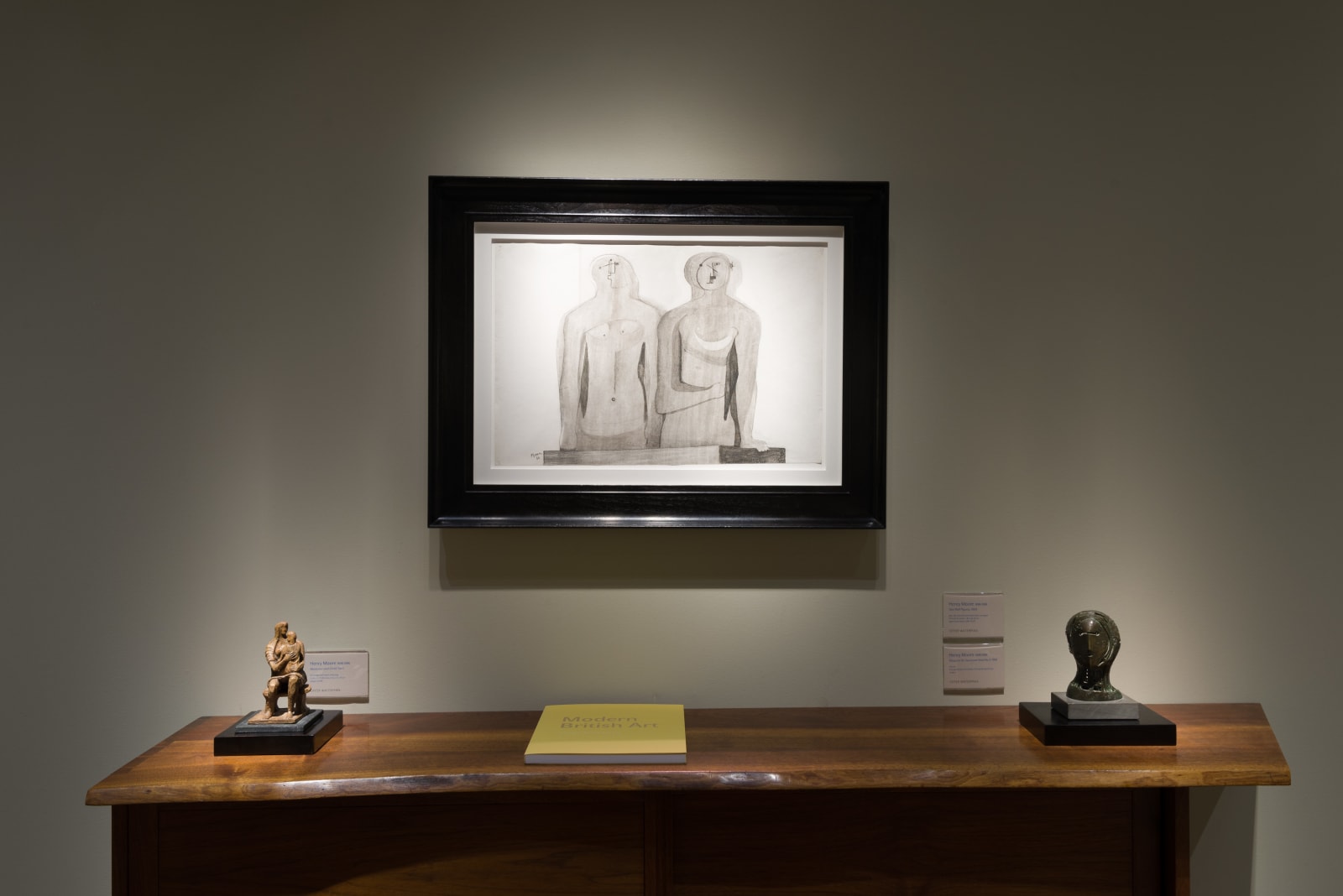Henry Moore 1898-1986
Two Half Figures, 1934
pen, ink, charcoal and watercolour on paper
14½ x 21 in.
36.5 x 53cm.
36.5 x 53cm.
signed and dated
HMF 34.23
HMF 34.23
Two Half Figures, 1934 was created during an exciting period in Henry Moore’s career, which saw him at the forefront of the European avant-garde. In 1929 he moved to Hampstead...
Two Half Figures, 1934 was created during an exciting period in Henry Moore’s career, which saw him at the forefront of the European avant-garde. In 1929 he moved to Hampstead where he was followed shortly after by Barbara Hepworth, Ben Nicholson, Naum Gabo, László Moholy-Nagy, Roland Penrose and Herbert Read. Amongst this international community of artists and critics there was a stimulating exchange of ideas concerning modernist art, ideas which informed Moore’s participation in the International Surrealist Exhibition in 1936.
Rejecting the idealised beauty of late Greek and Renaissance art in favour of the ‘power of expression’, during the 1930s Moore became increasingly preoccupied with the formal tension between figurative and abstract elements in his work. In 1937, Moore explained that he produced drawings “…as a means of generating ideas for sculpture… and [as] a way of sorting out ideas and developing them.” 1 The link between these two modes of working is particularly evident in the present drawing, where two half-figures stand side by side on a base, suggesting that the drawing is based on a pre-existing sculpture. Indeed, the subject is notably similar to several sculptures made between 1929 and 1932, particularly the Armenian marble carving, Half-Figure, 1932 (coll. Tate Gallery).
The sense that Moore is presenting a ‘sculptural’ idea of the body is enhanced by the formal qualities through which his figures are imagined. Although the forms are at first glance quite flattened, in fact areas of intricate cross-hatching convey a subtle sense of three-dimensionality. In other places shading is used to imply recesses which, if realised as sculpture, would be cavities or holes. On the right-hand figure, delicately drawn lines descend the interior arm and cross the body in a curve. These fine lines are analogous to how Moore might incise the surface of a carving, and are, also, perhaps an early imagining of the stringed sculptures he began to make in 1937.
There is a notable theme of doubling here; there are two figures, each with two ‘Cubist’ faces, and there is a doubling up of the various contour lines which describe the figures. In addition, Moore presents both exterior and interior aspects of the body – the left-hand figure’s breasts, appearing as if they are within a cavity in her torso. The impetus for Moore’s series of half-length female figures comes at least in part from his interest in primitivism and particularly ancient Sumerian sculpture. More contemporary influences on the present drawing include the abstract imagery of Joan Miró and the refracted abstraction of Picasso’s portraits, such as The Dream, 1932.
1 Moore, ‘The Sculpture Speaks’ reprinted in Henry Moore, Writings and Conversations, Lund Humphries, Aldershot, 2002, p196
Rejecting the idealised beauty of late Greek and Renaissance art in favour of the ‘power of expression’, during the 1930s Moore became increasingly preoccupied with the formal tension between figurative and abstract elements in his work. In 1937, Moore explained that he produced drawings “…as a means of generating ideas for sculpture… and [as] a way of sorting out ideas and developing them.” 1 The link between these two modes of working is particularly evident in the present drawing, where two half-figures stand side by side on a base, suggesting that the drawing is based on a pre-existing sculpture. Indeed, the subject is notably similar to several sculptures made between 1929 and 1932, particularly the Armenian marble carving, Half-Figure, 1932 (coll. Tate Gallery).
The sense that Moore is presenting a ‘sculptural’ idea of the body is enhanced by the formal qualities through which his figures are imagined. Although the forms are at first glance quite flattened, in fact areas of intricate cross-hatching convey a subtle sense of three-dimensionality. In other places shading is used to imply recesses which, if realised as sculpture, would be cavities or holes. On the right-hand figure, delicately drawn lines descend the interior arm and cross the body in a curve. These fine lines are analogous to how Moore might incise the surface of a carving, and are, also, perhaps an early imagining of the stringed sculptures he began to make in 1937.
There is a notable theme of doubling here; there are two figures, each with two ‘Cubist’ faces, and there is a doubling up of the various contour lines which describe the figures. In addition, Moore presents both exterior and interior aspects of the body – the left-hand figure’s breasts, appearing as if they are within a cavity in her torso. The impetus for Moore’s series of half-length female figures comes at least in part from his interest in primitivism and particularly ancient Sumerian sculpture. More contemporary influences on the present drawing include the abstract imagery of Joan Miró and the refracted abstraction of Picasso’s portraits, such as The Dream, 1932.
1 Moore, ‘The Sculpture Speaks’ reprinted in Henry Moore, Writings and Conversations, Lund Humphries, Aldershot, 2002, p196
Provenance
Julian Trevelyan, gifted by the Artist in the 1930s
Literature
Ann Garrould (ed.), Henry Moore: Complete Drawings Vol.2 1930-39, Lund Humphries, 1998, AG 34.23, illus b/w, p116



